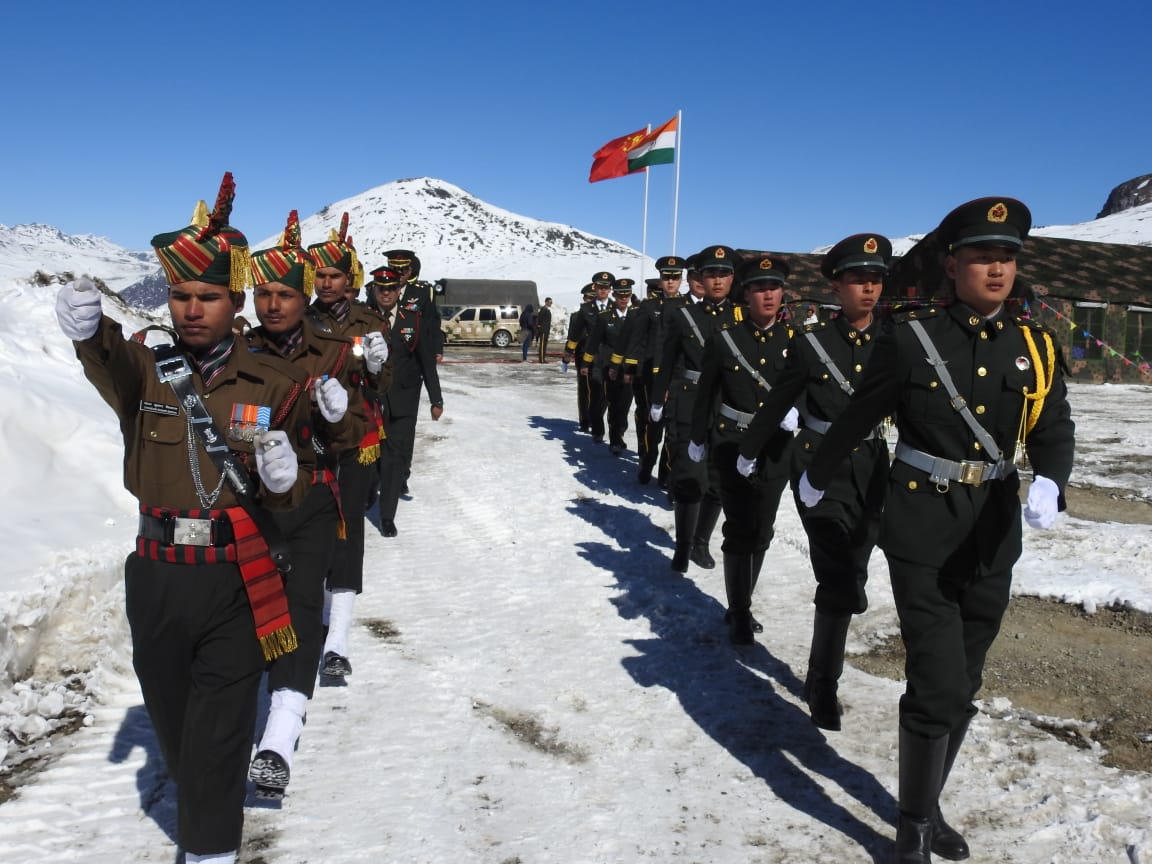A major military conflict is brewing at the heart of Asia. It could come to nothing, or it could affect four countries. It all depends on how valid the actions of those involved are going to be and whether other countries are going to undertake peacekeeping efforts.
On 23 May, it was reported that the Chinese People’s Liberation Army (PLA) had moved 5,000 soldiers into the mountainous region of Ladakh. This is not exactly a new development, since it is a disputed territory and both China and India have patrolled the area from time to time. There has also been trouble on the other side of the Himalayas – in Sikkim. In June 2017, for example, Indian soldiers crossed the border and effectively invaded the neighbouring country of Bhutan, where the Chinese were building a road.
By international standards, however, the current example is rather significant – it is the first time that foreign soldiers have invaded territory considered to be Indian since the Kargil War between India and Pakistan (under pressure from the US, Pakistan was eventually forced to withdraw its troops). Judging by the nature of the troops’ movements, the incursion by the Chinese soldiers is strategic – they entered five areas of Ladakh. Four of these are along the Galwan River and the fifth is near Pangong Lake.
In late April, heightened activity by the Chinese was observed in the area, but India did not take active countermeasures. On 5 May, Chinese soldiers began their invasion. Then, on 12 May, several incursions were carried out simultaneously into Demchok, southern Ladakh, and Naku La in northern Sikkim. There were 200 Chinese soldiers in Sikkim, but they have been withdrawn for the time being. The latest incident also involved an exchange of gunfire that injured 72 Indian soldiers, according to Indian sources. It is also reported that the PLA is preparing a similar advance into another area – southern Ladakh.
 The seriousness of China’s intentions can be seen in satellite images that show significant changes at the Ngari Gunsa airport just 200 kilometres away from Pangong Lake. These changes took place over the course of six weeks or so, the territory was expanded and new hangars appeared. Images from early May also recorded J-11 and J-16 fighter jets.
The seriousness of China’s intentions can be seen in satellite images that show significant changes at the Ngari Gunsa airport just 200 kilometres away from Pangong Lake. These changes took place over the course of six weeks or so, the territory was expanded and new hangars appeared. Images from early May also recorded J-11 and J-16 fighter jets.
In addition, on 25 May, China announced that it was going to start repatriating its citizens from India. The announcement was made under the guise of measures to combat the coronavirus, although, given the escalation in Ladakh, there is also a clear political dimension.
On 26 May, meanwhile, it was reported that there were now 10,000 Chinese soldiers on Indian territory. A public notice also appeared on the PLA’s website claiming that the entire Galwan River valley is a part of China. It states that “the Indian side crossed the line in the Galwan valley… and unilaterally change the status of the border. The Galwan valley is a Chinese territory, and the local control situation is very clear.”
On the Indian side, there are five areas along the line of control, which covers 800 kilometres, that have constantly been a cause for concern – Chumar, Demchok, Pangong, and two places near Daulat Beg Oldi.
Indian media outlets have taken different positions on the issue. The Hindustan Times only mentions Ladakh in relation to the coronavirus pandemic, which is affecting the tourism industry. The Times of India, meanwhile, writes that “in face of China’s continuing aggressive behavior… a few additional infantry battalions have been moved into Ladakh”. There is no mention of diplomatic negotiations. Chinese media outlets make no mention of them, either.
It is interesting that, while accusing China of aggressive actions, India had just carried out a similar intervention against Nepal. A road link was unilaterally opened between Dharchula, in the Indian state of Uttarakhand, and Lipulekh in Nepal. The road passes through the disputed territory of Kalapani and was inaugurated on 8 May by Indian Defence Minister Rajnath Singh. Nepal claims that Lipulekh, which is a strip of land in northwestern Nepal that borders India and China, is their territory. The Nepalese Ministry of Foreign Affairs holds the position that, in accordance with the 1816 Treaty of Sagauli that ended the Anglo-Nepalese War, Nepal claims all territories east of the Mahakali River, including Limpiyadhura, Kalapani and Lipulekh.
Primarily, India needs the new transport artery to shave several days off the Hindu Pilgrimage to Mount Kailash. It is telling that, back in November 2019, new maps were published in India showing these territories as part of India. At the same time, India annulled Article 370 of the Constitution, after which the territories of Kashmir and Ladakh lost their previous status.
 For its part, Nepal proposed that India resolve the issue of Kalapani, but India didn’t respond. Nepal reacted by publishing its own new political and administrative maps of the country on 20 May 2020 that show Lipulekh, Kalapani and Limpiyadhura as part of Nepal. This has now brought a cartographic dimension to the conflict, too. India was forced to speak out. On the same day, the official spokesperson of the Indian Ministry of External Affairs, Anurag Srivastava, said: “The Government of Nepal has released a revised official map of Nepal today that includes parts of Indian territory. This unilateral act is not based on historical facts and evidence. It is contrary to the bilateral understanding to resolve the outstanding boundary issues through diplomatic dialogue. Such artificial enlargement of territorial claims will not be accepted by India.” India made no mention of the Treaty of Sagauli, however, as if it did not exist.
For its part, Nepal proposed that India resolve the issue of Kalapani, but India didn’t respond. Nepal reacted by publishing its own new political and administrative maps of the country on 20 May 2020 that show Lipulekh, Kalapani and Limpiyadhura as part of Nepal. This has now brought a cartographic dimension to the conflict, too. India was forced to speak out. On the same day, the official spokesperson of the Indian Ministry of External Affairs, Anurag Srivastava, said: “The Government of Nepal has released a revised official map of Nepal today that includes parts of Indian territory. This unilateral act is not based on historical facts and evidence. It is contrary to the bilateral understanding to resolve the outstanding boundary issues through diplomatic dialogue. Such artificial enlargement of territorial claims will not be accepted by India.” India made no mention of the Treaty of Sagauli, however, as if it did not exist.
On 25 May, the Nepalese army stated that it was ready to counter the Indian army in the disputed, high-altitude region. Apparently, the military is already making a road to reach the high-altitude villages of Tinkar and Changru.
Another thread of the conflict is Kashmir, which borders Ladakh. The dispute between Pakistan and India over the region has been going on since 1947, but India has recently stepped up its efforts. The coronavirus pandemic has played into India’s hands – lockdown measures have turned Jammu and Kashmir into a no-go area. It is worth considering that there are around 900,000 police, security and military personnel in the Indian-controlled area. In fact, it is the most militarised region in the world. And since the incident in February 2019, when an Indian Air Force jet was shot down over Pakistan, tensions between the two countries have reached new heights. Although Pakistani Prime Minister Imran Khan demonstrated an act of good faith and handed over the captured Indian pilot, New Delhi showed little interest in settling their differences any further.
This whole knot of conflicts shows the region’s explosive potential. In addition, China and Pakistan are long-time allies against India, while, of late, Beijing has been actively supporting Nepal, preventing New Delhi from shifting the balance in its favour. This could lead to the creation of a tripartite alliance against India that would begin coordinated actions against the country, including through the use of international platforms. UN Security Council Resolutions on previous conflicts (most particularly, the need for a referendum in Kashmir to decide its future) have been unable to make a difference. Let’s see if the situation changes now. Chances are that events will develop on the basis of intuition, logic, and the decisions taken by the leaders of the four countries.














The Fiction in this article can gauged from the fact that
1) the so called Indian source linked in the article is a pro Pakistan kashmiri news blog with articles glorifying kashmiri terrorists and even that link doesn’t talk about “gunfire” while hiding the fact that there were over 150 injuries on the Chinese side.
2) In Sikkim an Indian officer also broke the face of the leader of the Chinese soldiers.
3)Forget about waging a war against India, rather the Chief of Nepalese Army ignored Pm Oli’s (Chinese puppet) request and refused to comment on the issue calling it a political matter and not a military one.
4) Chinese can call the whole solar system as Chinese territory but the last time they tried to take Sikkim by force India killed over 300 Chinese soldiers loosing only 40 of our own.
5)Any military response by India will forever burst the “Chinese Bubble” and damage Chinese expansionist projects in south china sea.
Present Indian restraint is only because India doesn’t want to join the western camp and not be used by US as a pawn.India would rather sit on the sidelines and watch the US,NATO, China conflict which is inevitable, while giving itself the flexibility and Independence to not become a collateral damage.
If however China attacks India directly ,India will be happy to teach China painful lessons that they will not forget in a hurry.
Informative article on the military conflict in the region which is fast escalating despite the pandemic. The writer has brilliantly explained all the links from Ladakh to Nepal to Kashmir. India’s policy of interference in affairs of neighbouring countries is a constant threat to regional stability. One key aspect overlooked by India in the current conflict is China’s cyberspace and electronic warfare capabilities which can prove to be a game-changer. Hope sanity will prevail.
A nation which cannot plan the onion crop,is going to go to war,with the PRC.What is the pointer for the PLA ? The basic flaw of the Indian weasels and cowards is – their inability to plan for contingencies,and their impotence,at the time of execution of plans. dindooo hindoo
In the wars with Pakistan,id.est,the land wars,The Pakistanis never really tested the Indians.A pre-emptive attack,just has some surprise value,which is a part,of contingency planning.Since the Indians had the numbers – they could blunder and flounder,their way,to a defense.
So we levitate and move to Galwan.If the PLA cuts off the supply and communication lines of the Indian weasesls,and kills of their operational heads (Majors etc),the Indian clowns will just collapse or run away. 1stly,as they are cowards – and 2ndly,as there is no plan,for that eventuality.If Chinese Int scans Indians,in PRC,HK,Singapore – then,besides being weasels,cowards,dumb,petty and unattractive – they are RISK AVERSE.
Place the battlefield situation – when their supply and communication lines,are cut,and their operational trench commander,is killed – what will these Indian Apes do ? They will run away – just like in 1962 – because there is NO PLAN,for that eventuality – and even if there was one,it was NOT TESTED,and Indians ALWAYS fail,to execute plans.And all that will be compounded,by their being RISK AVERSE – which means, that there will BE NO INNOVATION AND CREATIVITY.
There is NOTHING NEW about this.Even the Mughals wrote about the pathetic battle stretegy and tactics of the Indians.Even then,when the Military Commander of King was killed – the army ran off – partly,as they are cowards,but mainly,because the planner was dead,and so was the person who directed the execution,of the plans.The Tibetans in the Indian Army,are OBSOLETE.The stage of rock fighting is over.Minus 30 degrees war in Ladakh,is a TECHNOLOGY WAR,with PLANNING and PERFECT EXECUTION,backed by deep and efficient logistics.These are NOT Indian Traits or IndianAreas of Competency (let alone,excellence)
Indians have never fought a war,at MINUS 30 degrees.Thus,there is no REALISTIC PLAN,and even when that plan is rolled out,there will be disasters and contingencies,for which the Indians will have no solutions,and their communication lines with the HQ and Delhi,will be CUT.
Further,the Indians have NO INT on PLA technology,which will be used at MINUS 30 degrees warfare,and PRC logistics are way ahead of India.Mistakes on the battlefield,can ONLY BE CORRECTED,by Logistics – in a large quantum,and the minimal time.India is NO Match,in that domain.Besides,Indian Logistics can be sabotaged,from Inside India,and,by using Indians – and India,has no similar capabilities,in Tibet (even for,rake and road logistics)
This is Y, the PLA will doom the Indian Army.dindooohindoo
A nation which cannot manage Onion Prices,Annual Monsoon Floods,COVID,where 1000s of farmers hang every year,will fight a war with the PRC ?
With the start of the 3 rd wave of COVID in India in the next few months – 1 can expect the PLA to strike in Arunachal and Bhutan